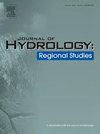中国小兴安岭北部农业区浅层地下水硝酸盐污染的来源分配与健康风险
IF 4.7
2区 地球科学
Q1 WATER RESOURCES
引用次数: 0
摘要
研究区域:东北农业重点地区小兴安岭北部。由于农业集约化和人类活动,地下水硝酸盐(NO₃⁻)污染已经成为一个广泛关注的问题。本研究采用水化学分析、多元统计和健康风险评价等方法,对重庆市硝酸盐污染的来源、空间分布和健康风险进行了调查。采用绝对主成分评分-多元线性回归(APCS-MLR)对污染源进行量化,采用蒙特卡罗模拟对不同人群的健康风险进行评估。地下水NO₃⁻浓度平均为31.06 mg/L, 60% %的样本超过三级水质标准。APCS-MLR发现农业活动是主要污染源(64.04 %),其次是生活污水(24.14 %),污染热点集中在集约化农区。水化学分析揭示了两种主要的地下水类型:Ca-HCO₃和Ca-Cl(NO₃+SO₄),后者与人为污染有关。健康风险评估强调,婴儿是最脆弱的群体,其第95百分位危害商数为2.38,明显超过安全阈值。区分农业和家庭污染源的关键因素包括NO₃⁻,Cl⁻和SO₄²⁻之间的特殊相关性,吉布斯图中的水化学模式,以及与土地使用的空间对应关系。这一综合特征为在这一农业重要地区实施有针对性的硝酸盐管理策略提供了科学依据。本文章由计算机程序翻译,如有差异,请以英文原文为准。
Source apportionment and health risks of nitrate pollution in shallow groundwater in the agricultural Northern Xiaoxing' an Mountains region of China
Study region
Northern Xiaoxing'an Mountains, a key agricultural region in Northeast China.
Study focus
Groundwater nitrate (NO₃⁻) contamination has become a widespread concern due to agricultural intensification and anthropogenic activities. This study investigated the sources, spatial distribution, and health risks of nitrate pollution using hydrochemical analysis, multivariate statistical methods, and health risk assessment. APCS-MLR (Absolute Principal Component Scores-Multiple Linear Regression) was employed to quantify pollution sources, while Monte Carlo simulation was utilized to assess health risks among different population groups.
New hydrological insights for the region
Groundwater NO₃⁻ concentrations averaged 31.06 mg/L, with 60 % of samples exceeding Class III water quality standards. APCS-MLR identified agricultural activities as the dominant pollution source (64.04 %), followed by domestic sewage (24.14 %), with pollution hotspots concentrated in intensive farming areas. Hydrochemical analysis revealed two predominant groundwater types: Ca-HCO₃ and Ca-Cl(NO₃+SO₄), with the latter associated with anthropogenic contamination. Health risk assessment highlighted infants as the most vulnerable group, with a 95th percentile Hazard Quotient of 2.38, significantly exceeding the safety threshold. Key factors distinguishing agricultural and domestic pollution sources included distinctive correlations between NO₃⁻, Cl⁻, and SO₄²⁻, hydrochemical patterns in Gibbs diagrams, and spatial correspondence with land use. This comprehensive characterization provides a scientific foundation for implementing targeted nitrate management strategies in this agriculturally important region.
求助全文
通过发布文献求助,成功后即可免费获取论文全文。
去求助
来源期刊

Journal of Hydrology-Regional Studies
Earth and Planetary Sciences-Earth and Planetary Sciences (miscellaneous)
CiteScore
6.70
自引率
8.50%
发文量
284
审稿时长
60 days
期刊介绍:
Journal of Hydrology: Regional Studies publishes original research papers enhancing the science of hydrology and aiming at region-specific problems, past and future conditions, analysis, review and solutions. The journal particularly welcomes research papers that deliver new insights into region-specific hydrological processes and responses to changing conditions, as well as contributions that incorporate interdisciplinarity and translational science.
 求助内容:
求助内容: 应助结果提醒方式:
应助结果提醒方式:


